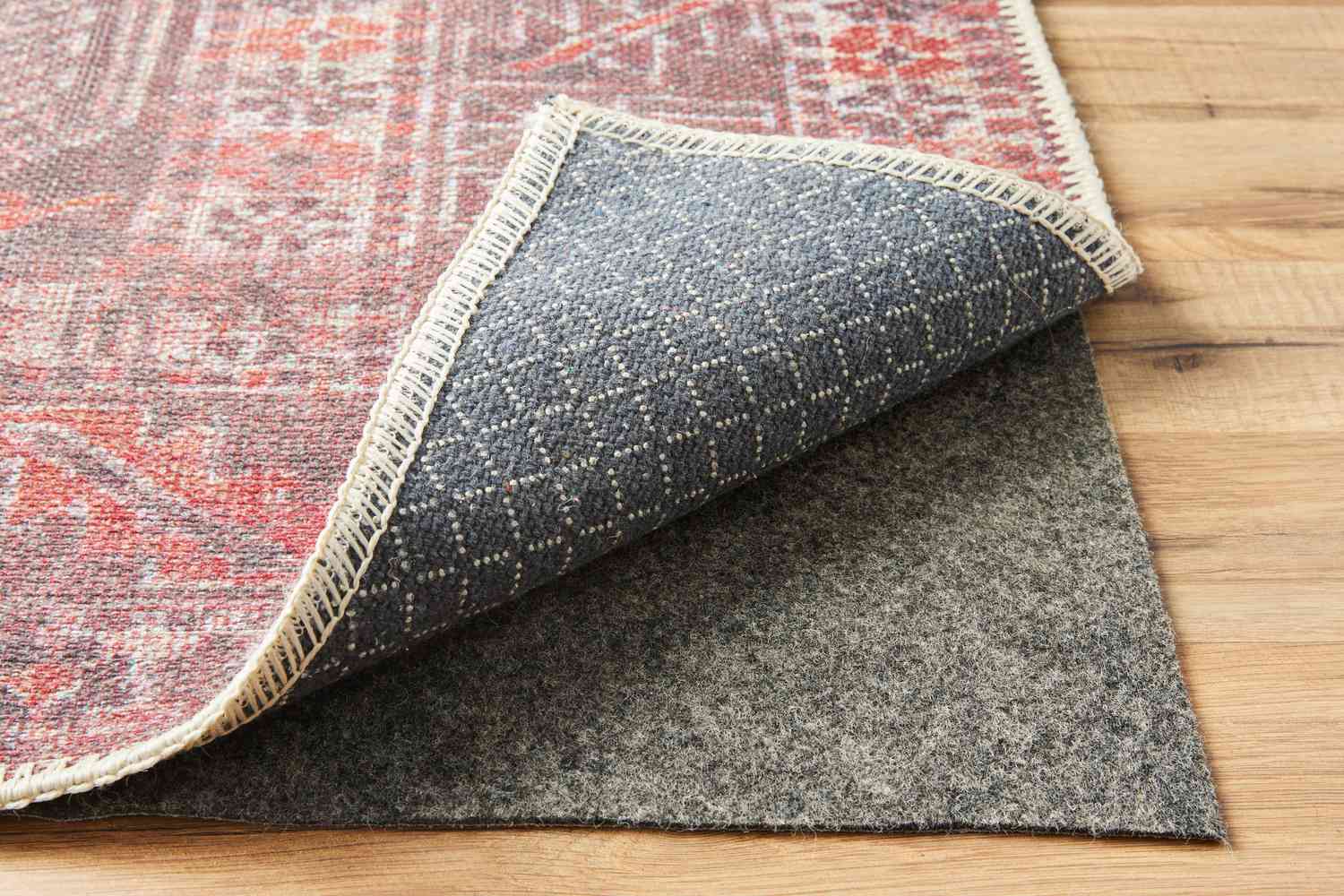
I. Introduction
A. Importance of Rug Stability
Rugs not only add aesthetic appeal to a room but also serve functional purposes such as providing comfort and reducing noise. However, a sliding or shifting rug can pose safety hazards and diminish the overall look of the space.
B. Common Challenges Faced
Many homeowners encounter the frustration of constantly readjusting rugs due to factors like foot traffic, pet activity, or slippery flooring surfaces.
C. Overview of Solutions
Fortunately, several methods and products are available to help keep rugs in place, ensuring stability and safety in your living spaces.
II. Rug Grippers and Rug Pads
A. Understanding Rug Grippers
Rug grippers are adhesive or non-adhesive strips placed under the corners or edges of rugs to prevent them from sliding or bunching up. They come in various types, each with its unique features and benefits.
1. Types of Rug Grippers
Adhesive grippers use sticky material to adhere to both the rug and the floor, providing a strong hold. Non-adhesive grippers use friction or suction to keep the rug in place without leaving residue on the floor.
2. How Rug Grippers Work
Adhesive grippers create a bond between the rug and the floor, while non-adhesive grippers rely on their textured surface to grip the rug and prevent movement.
3. Benefits and Drawbacks
Adhesive grippers offer a secure hold but may leave residue on the floor or damage certain rug materials. Non-adhesive grippers are easy to reposition and remove but may not provide as strong a hold on smooth surfaces.
B. Exploring Rug Pads
Rug pads are cushioned underlays placed beneath rugs to provide additional support, cushioning, and stability. They come in various materials and thicknesses to suit different flooring types and rug sizes.
1. Different Types of Rug Pads
Felt pads offer soft cushioning and protection for hardwood floors, while rubber pads provide grip and prevent slipping on smooth surfaces like tile or laminate. Non-slip pads combine the benefits of both materials for versatile use.
2. Purpose and Functionality
Rug pads help prevent rugs from shifting or bunching up, extend the lifespan of both rugs and flooring, and provide additional cushioning and insulation.
3. Considerations When Choosing a Rug Pad
When selecting a rug pad, consider factors such as the type of flooring, rug size, thickness preference, and desired level of grip and cushioning.
C. Tips for Proper Installation and Maintenance
To ensure optimal performance and longevity, it’s essential to properly install rug grippers and pads and follow maintenance guidelines.
1. Cleaning and Preparing the Surface
Before installing grippers or pads, clean the floor surface thoroughly to remove any dirt, dust, or debris that could affect adhesion or grip.
2. Positioning Rug Grippers and Pads Correctly
Place rug grippers evenly under the corners or edges of the rug, ensuring they are securely attached to both the rug and the floor. For rug pads, trim them to fit the size of the rug and position them flatly underneath.
3. Regular Inspection and Replacement
Periodically check the condition of rug grippers and pads to ensure they are still providing adequate grip and support. Replace them as needed to maintain rug stability and prevent slipping or damage to flooring.
III. Double-Sided Tape and Caulking
A. Double-Sided Carpet Tape
Double-sided carpet tape is a strong adhesive tape applied to the underside of rugs to secure them to the floor, particularly on hard surfaces like tile or laminate.
1. How Double-Sided Tape Works
Double-sided tape creates a strong bond between the rug and the floor, preventing shifting or movement even in high-traffic areas.
2. Ideal Surfaces for Application
Double-sided tape works best on smooth, clean surfaces such as hardwood, tile, or laminate flooring.
3. Precautions and Removal
Before applying double-sided tape, ensure the floor surface is clean and dry to maximize adhesion. When removing tape, use caution to avoid damaging the flooring finish.
B. Caulking
Caulking is a sealant used to fill gaps and cracks in flooring or between tiles, providing a secure bond that prevents rugs from slipping or shifting.
1. Application of Caulking for Rug Stability
Apply a thin bead of caulk along the edges or corners of the rug to create a barrier that prevents movement.
2. Suitable Surfaces and Conditions
Caulking works well on surfaces that are not frequently exposed to moisture or humidity, as moisture can affect the adhesion of the caulk.
3. Removal and Cleaning Process
To remove caulk, use a putty knife or scraper to gently lift it from the surface. Clean the area thoroughly to remove any residue before reapplying or replacing the rug.
C. Pros and Cons of Using Tape and Caulking
Consider the advantages and disadvantages of using double-sided tape and caulking for rug stability to determine the best option for your specific needs and preferences.
1. Durability and Effectiveness
Double-sided tape provides a strong and reliable hold, while caulking creates a more permanent bond that may be difficult to remove.
2. Impact on Flooring and Rug Fibers
Double-sided tape may leave residue on the floor or damage certain rug materials, while caulking can cause discoloration or staining if not applied properly.
3. Considerations for Different Environments
When choosing between tape and caulking, consider factors such as the type of flooring, rug material, and environmental conditions to ensure optimal performance and longevity.
IV. Velcro and Furniture Anchors
A. Velcro Strips
Velcro strips are hook-and-loop fasteners used to secure rugs to the floor, providing a customizable and reusable solution for rug stability.
1. Application on Rugs and Floors
Attach one side of the Velcro strip to the underside of the rug and the other side to the floor to create a secure bond that prevents slipping or shifting.
2. Velcro Compatibility with Different Rug Types
Velcro strips are suitable for use with a wide range of rug materials and sizes, providing versatile and customizable options for rug stability.
3. Advantages and Disadvantages
Velcro strips offer ease of installation and repositioning, but they may lose their adhesive properties over time and require periodic replacement.
B. Furniture Anchors
Furniture anchors are devices used to secure rugs to the floor by anchoring them to heavy furniture or fixtures in the room.
1. Using Furniture Anchors to Secure Rugs
Attach one end of the furniture anchor to the rug and the other end to a heavy piece of furniture or fixture to prevent the rug from shifting or sliding.
2. Compatibility with Various Floorings
Furniture anchors can be used on a variety of flooring surfaces, including hardwood, tile, laminate, and carpet, providing a versatile solution for rug stability.
3. Considerations for Heavy Furniture and Traffic Areas
When using furniture anchors, ensure that the furniture or fixture used for anchoring is heavy enough to prevent movement, especially in high-traffic areas.
C. Tips for Effective Use and Maintenance
To maximize the effectiveness and longevity of Velcro strips and furniture anchors, follow these tips for proper installation and maintenance.
1. Proper Installation Techniques
Ensure that Velcro strips are securely attached to both the rug and the floor, and that furniture anchors are anchored to stable and heavy furniture or fixtures.
2. Regular Inspection and Adjustment
Periodically check the condition of Velcro strips and furniture anchors to ensure they are still providing adequate support and stability. Adjust or replace them as needed to maintain rug security.
3. Addressing Wear and Tear
If Velcro strips lose their adhesive properties or furniture anchors become damaged or worn, replace them promptly to prevent rug slippage and maintain safety in the home.
V. Alternative Methods and Additional Tips
A. Weighing Down the Rug Edges
In addition to adhesive solutions and anchoring devices, you can also weigh down the edges of the rug to prevent slipping or shifting.
1. Using Heavy Objects or Furniture
Place heavy objects or furniture along the edges of the rug to hold it in place and prevent movement.
2. Implementing Decorative Solutions
Incorporate decorative elements such as weighted decor or planters along the edges of the rug to provide stability while enhancing the aesthetic appeal of the space.
3. Precautions and Limitations
Ensure that the heavy objects or furniture used to weigh down the rug edges are stable and will not pose a tripping hazard or damage the flooring.
B. Incorporating Rug Tacks or Nails
For rugs placed in permanent locations, you can use rug tacks or nails to secure them to the floor and prevent shifting or sliding.
1. Suitable Surfaces for Installation
Rug tacks or nails can be used on hardwood, tile, or concrete floors, providing a secure and permanent solution for rug stability.
2. Proper Handling and Placement
When installing rug tacks or nails, use caution to avoid damaging the rug fibers or flooring surface. Place them along the edges or corners of the rug for optimal stability.
3. Risks and Considerations
Be aware that rug tacks or nails may leave permanent marks on the flooring and should only be used in areas where the rug will remain in place for an extended period.
C. Regular Maintenance Practices
To ensure that your rugs stay in place and maintain their appearance over time, incorporate regular maintenance practices into your cleaning routine.
1. Vacuuming and Cleaning Routine
Regularly vacuum and clean both the rug and the floor beneath it to remove dirt, dust, and debris that could affect rug stability and appearance.
2. Addressing Slipping and Shifting Promptly
If you notice any signs of slipping or shifting, address them promptly by readjusting rug grippers, pads, or other securing methods to prevent accidents or damage to the rug or flooring.
3. Consulting Professionals for Complex Situations
If you encounter persistent issues with rug stability or are unsure which securing method is best for your specific needs, consider consulting with a professional rug specialist or flooring expert for personalized advice and recommendations.
In conclusion, there are several effective methods and products available to keep rugs in place and prevent slipping or shifting. By understanding the different options and considering factors such as rug type, flooring surface, and environmental conditions, you can choose the best solution to ensure that your rugs stay securely anchored and enhance the safety and aesthetics of your living spaces.


